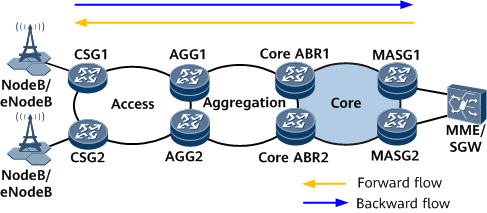Application of Bidirectional iFIT Flow Instances
If a static iFIT instance is configured and the instance type is set to bidirectional, a backward iFIT instance can be dynamically generated to implement bidirectional flow detection. This reduces the configuration and maintenance workload. Bidirectional flow-based iFIT is implemented as follows:
- Configure a bidirectional iFIT flow instance on the ingress.
- On the egress node, iFIT parses information in the forward flow and swaps the source and destination addresses to dynamically generate a backward iFIT flow.
Figure 1 shows an application of iFIT on a typical IP RAN. There are a large number of CSGs but only a few MASGs on the network. After static iFIT instances are configured on MASGs, the backward iFIT instance from a CSG to an MASG is automatically generated after the detected traffic reaches the CSG, greatly reducing the configuration and maintenance workload.

Bidirectional flow measurement applies to all scenarios that support 5-tuple-based measurement.
